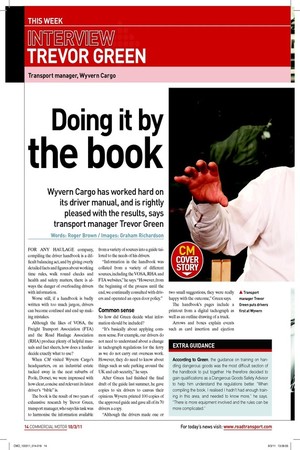Doing
Page 13

If you've noticed an error in this article please click here to report it so we can fix it.
it by
the book
Wyvern Cargo has worked hard on its driver manual, and is rightly pleased with the results, says transport manager Trevor Green
Words: Roger Brown / Images: Graham Richardson
FOR ANY HAULAGE company, compiling the driver handbook is a dificult balancing act, and by giving overly detailed facts and igures about working time rules, walk round checks and health and safety matters, there is always the danger of overloading drivers with information.
Worse still, if a handbook is badly written with too much jargon, drivers can become confused and end up making mistakes.
Although the likes of VOSA, the Freight Transport Association (FTA) and the Road Haulage Association (RHA) produce plenty of helpful manuals and fact sheets, how does a haulier decide exactly what to use?
When CM visited Wyvern Cargo’s headquarters, on an industrial estate tucked away in the neat suburbs of Poole, Dorset, we were impressed with how clear, concise and relevant its latest driver’s “bible” is.
The book is the result of two years of exhaustive research by Trevor Green, transport manager, who says his task was to harmonise the information available from a variety of sources into a guide tailored to the needs of his drivers.
“Information in the handbook was collated from a variety of different sources, including the VOSA, RHA and FTA websites,” he says. “However, from the beginning of the process until the end, we continually consulted with drivers and operated an open door policy.”
Common sense
So how did Green decide what information should be included?
“It’s basically about applying common sense. For example, our drivers do not need to understand about a change in tachograph regulations for the ferry as we do not carry out overseas work. However, they do need to know about things such as safe parking around the UK and cab security,” he says.
After Green had inished the inal draft of the guide last summer, he gave copies to six drivers to canvas their opinions. Wyvern printed 100 copies of the approved guide and gave all of its 70 drivers a copy.
“Although the drivers made one or two small suggestions, they were really happy with the outcome,” Green says.
The handbook’s pages include a printout from a digital tachograph as well as an outline drawing of a truck.
Arrows and boxes explain events such as card insertion and ejection














































